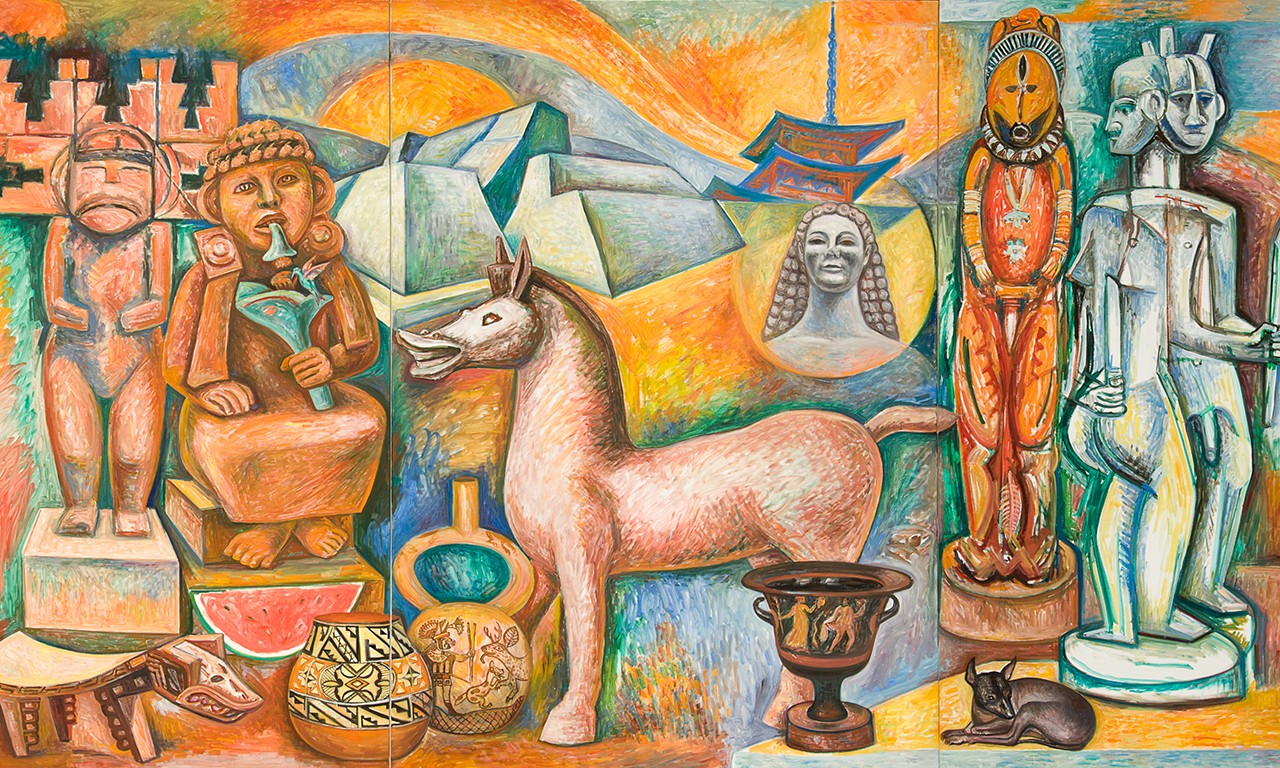 |
Untitled (Artworks of the Bowers Museum), 1999
Raúl Anguiano (Mexican, 1915-2006)
Oil on canvas; 101 1/2 x 183 1/2 x 1 1/2 in.
99.63.1
Gift of Bowers Museum Collectors Council |
Memory Palace
If you have been missing the Bowers Museum as much as we have, then perhaps you too have been walking its halls in your imagination and picturing the placements of objects. While the Bowers’ galleries hold many iconic treasures, one stands above all other in the degree to which it is a quintessentially Bowers object, and that is Raúl Anguiano’s 1999 untitled mural-homage to the many cultures represented in the museum’s collections. Adorning the Thompson Foyer which connects the Bowers’ north and south wings, the objects featured in this brilliant survey would have once been familiar to any visitor to the museum but may now be somewhat obscure. For the first time since the work was painted, the Bowers Blog tracks down each of its elements and provides a little background into what they are.
|
|
| Photographs of Raúl Anguiano painting the untitled mural painting, 1999 |
Demur a List, Paint from the Heart
Raúl Anguiano was born in Guadalajara, Mexico in 1915, and over the course of the century became one of the most famous second-generation Mexican muralists. Around 1999, the Bowers Collector’s Council—especially with the help of the late Richard Barrutia and his wife Kathy Barrutia who is still an active supporter of the museum—helped raise funds to commission two mural-size paintings on canvas from Anguiano. One of these, which the Bowers Blog previously wrote about in Raul Anguiano's "The Mayas" illustrates scenes of Mayan mythology from the Dresden Codex. Unfortunately, aside from a wealth of information on the supplies he used to paint the murals, the Bowers retained little documentation on Anguiano’s process for selecting the subjects for his untitled masterpiece. The final selection is an interesting one, with nine Bowers objects, two personal tributes, and three architectural and sculptural icons used to show the scope of world culture shared at the Bowers.
Beginning on January 6th, 1999, Anguiano came to the Bowers Museum Tuesday through Sunday from 11:30 am to 4:30 pm to paint the below. Use this key to navigate the remainder of the post:
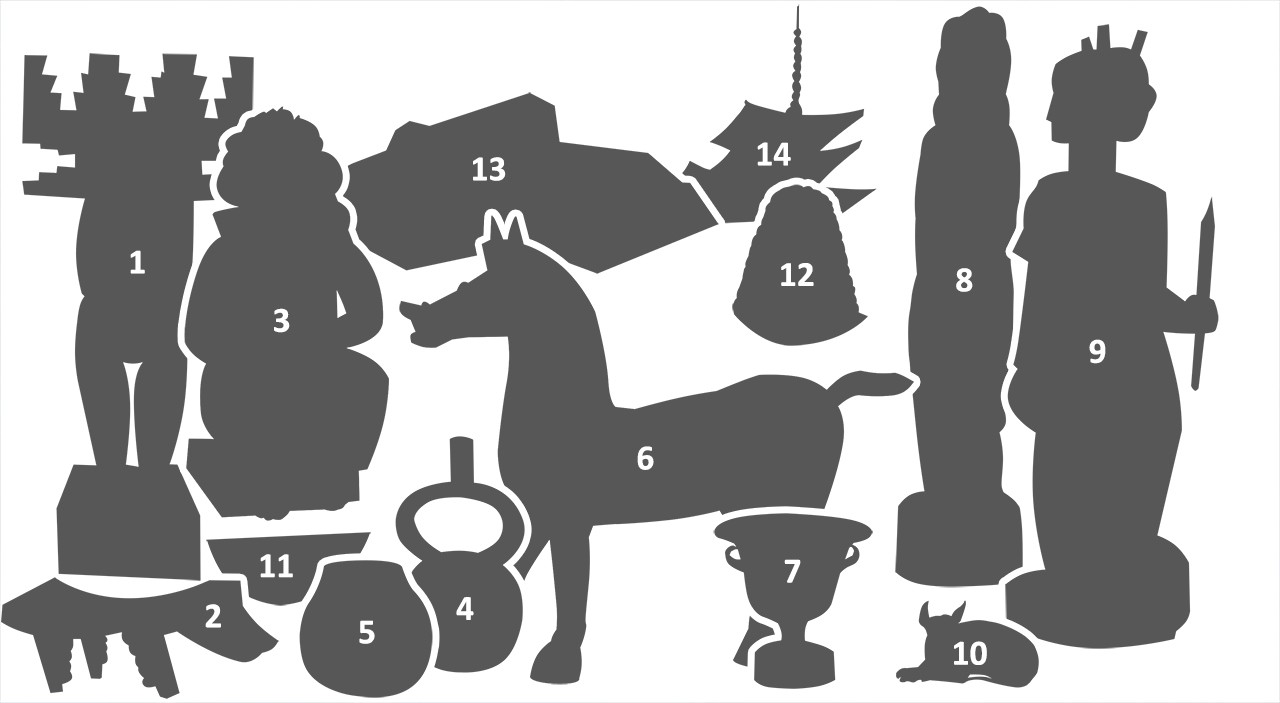
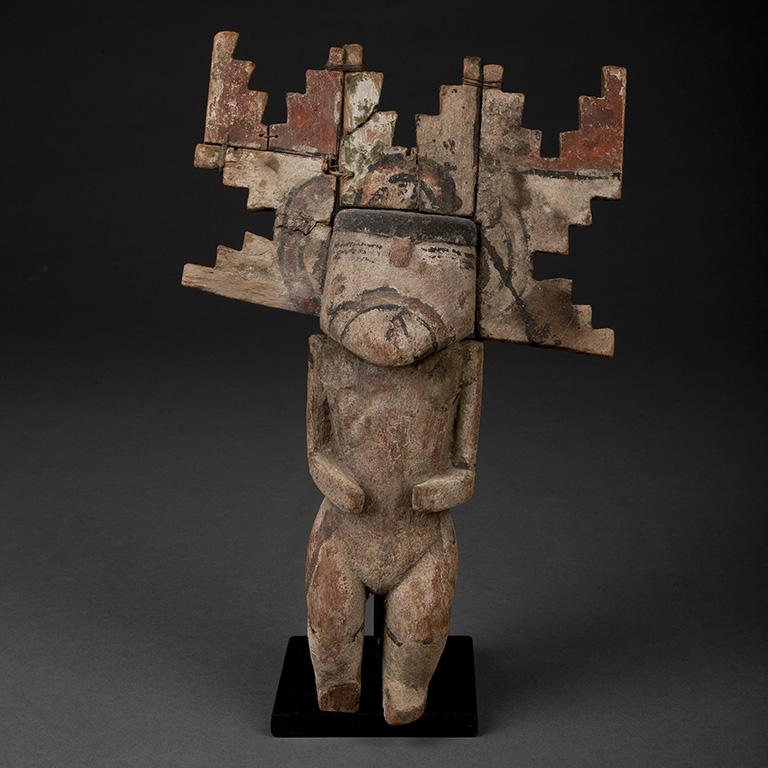 |
1. Hopi Kachina: Kachina dolls embodied the animistic spirits of the Hopi. The specific being represented here is the Shalako Mana, the female companion to the Shalako Taka kachina—the pair would originally have danced as a pair at a ceremony that occurred every twenty to thirty years. The signature headdress worn by this kachina is in a tablita style, with the stepped crown representing clouds. This object is currently in Collections Storage. |
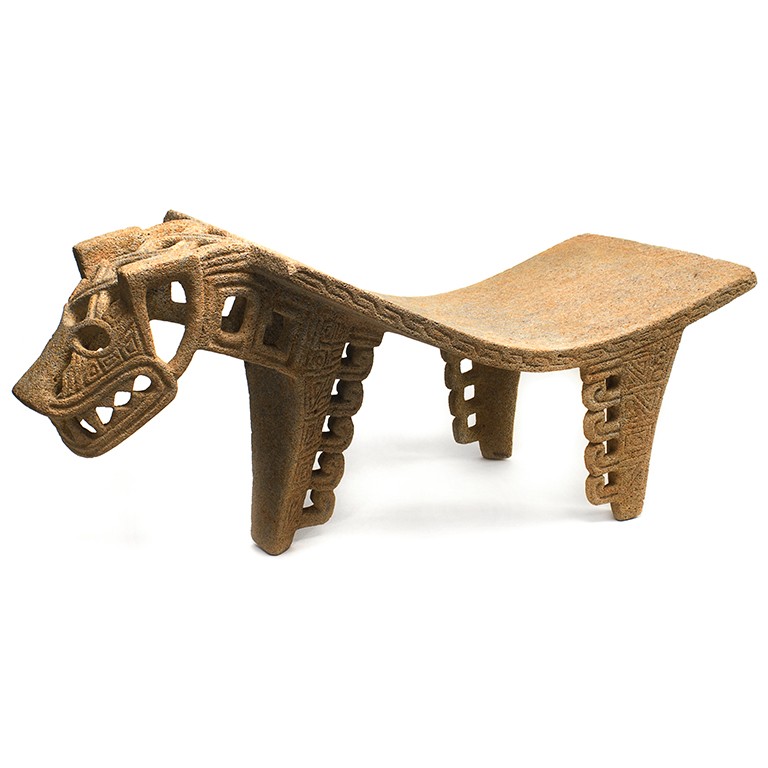 |
2. Costa Rican Jaguar Metate: This stone metate in the form of a jaguar with a repeating parrot motif is said to represent the soul of shapeshifted shaman. The meaning behind the repetition of the parrot, is that when depicted upside-down as it is here, it becomes a symbol of the underworld. In addition to their other roles, shamans of what is today’s Costa Rica’s Guanacaste-Nicoya Zone were guides to protect the souls of the dead through the underworld. Visitors will likely recognize this metate, which is on display only a few steps away from Anguiano’s mural. |
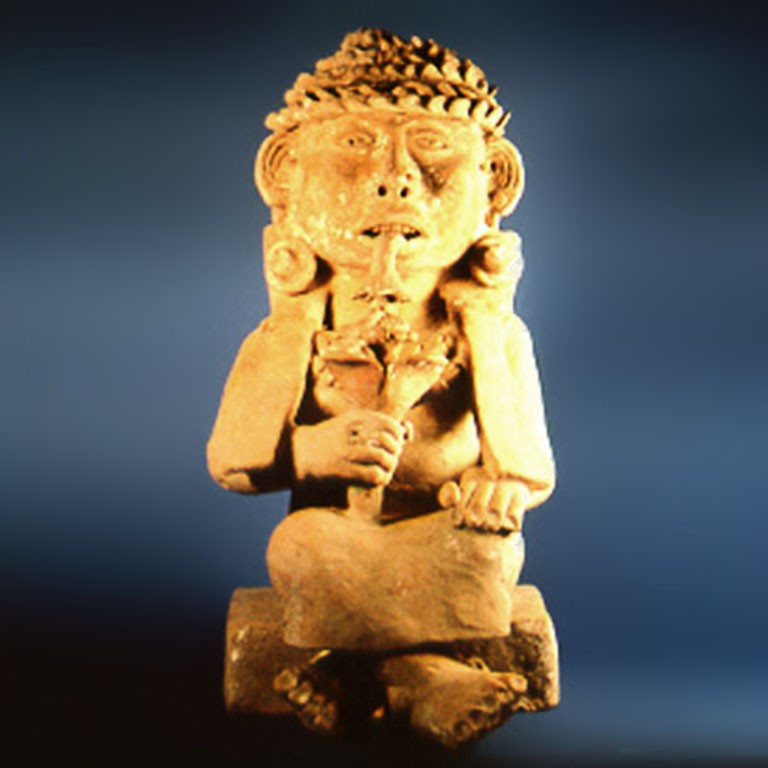 |
3. Huastec Seated Woman: The beautiful craftsmanship of this pottery sculpture belies a tragic backstory. The young woman that is depicted has been chosen to be honored as a sacrifice. The flower she is chewing on is hallucinogenic, from a tree that grows in Veracruz. The small hummingbird sucking from the flower in her hand may symbolize the rebirth of her spirit in a blissful afterlife. This object is currently in Collections Storage. |
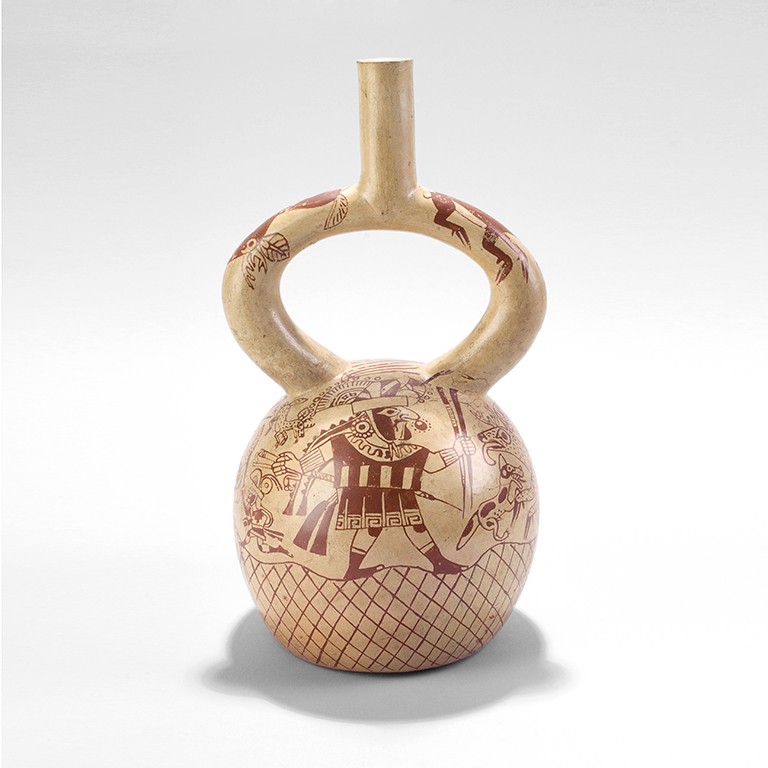 |
4. Moche Stirrup Vessel: Despite the fascinating shape of this vessel, the iconography of its design is perhaps the most telling as it illustrates the clothing and hunting practices of Peru over 1500 years ago. There are several interpretations of the painted scene in which two elaborately dressed figures hunt deer with atlatl and dogs: that it is a noblemen’s hunt, that the hunt is being performed by shamans and is a spiritual hunt, or that it is some combination thereof. This object is currently in Collections Storage. |
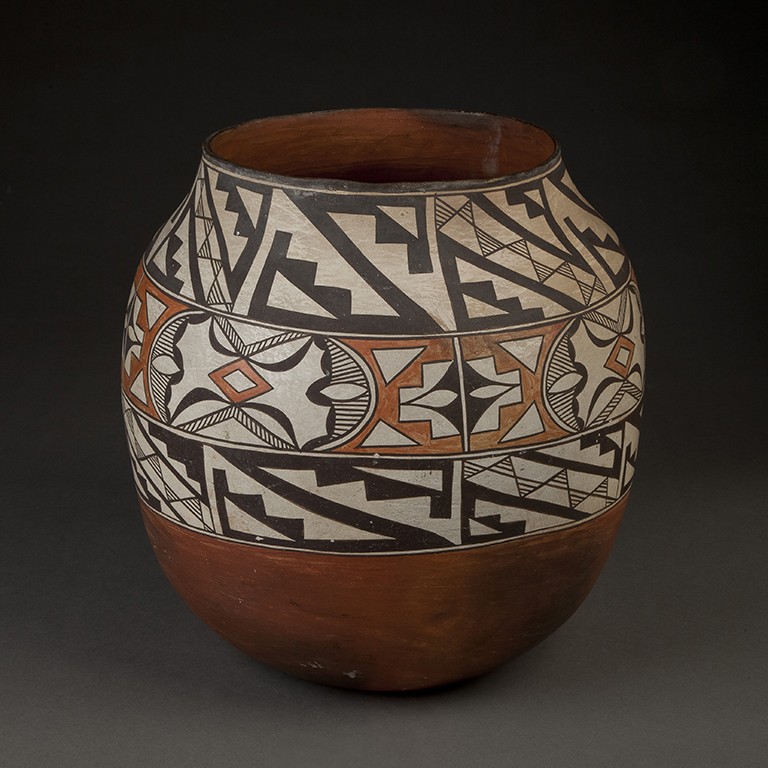 |
5. Acoma Pueblo Olla: This remarkable storage jar or olla is reputed to have won a first prize award at the International Exposition held in San Francisco in 1915. Decorated in white, black and red geometric motifs, it was created as part of a larger renaissance of Native American pottery by an Acoma artisan. This object is currently in Collections Storage. |
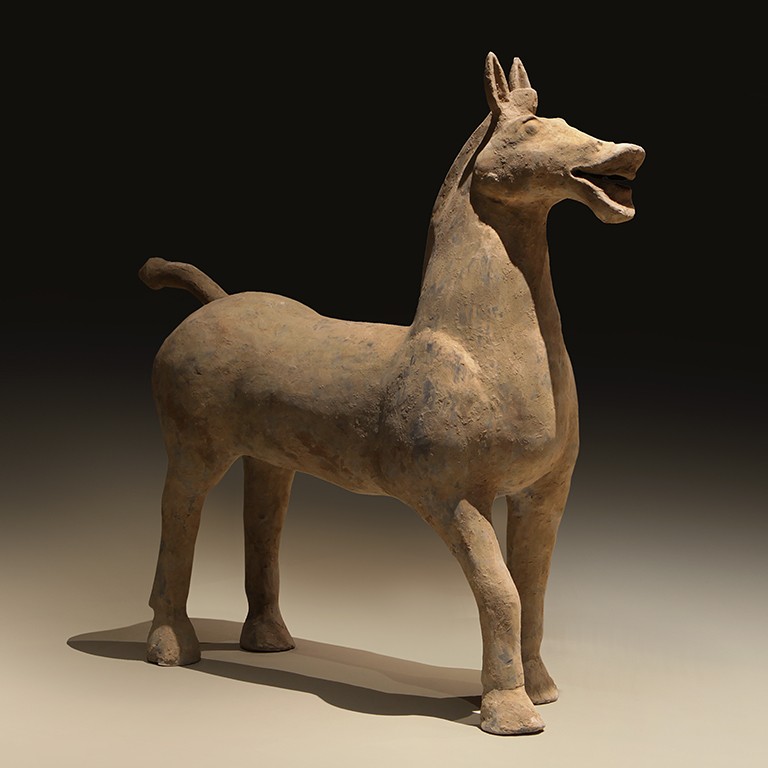 |
6. Han Dynasty Terracotta Horse: Before the Bowers had a stable of ceramic horses on display in our Ancient Arts of China: A 5000 Year Legacy exhibition—where this sculpture currently resides—this lone ceramic steed showed the multimillennial role of horses in Chinese history. The attentive ears, bulging eyes, flaring nostrils, a manicured mane and knotted tail along with the open mouth and raised front leg all indicate that this horse is well-bred and lively. |
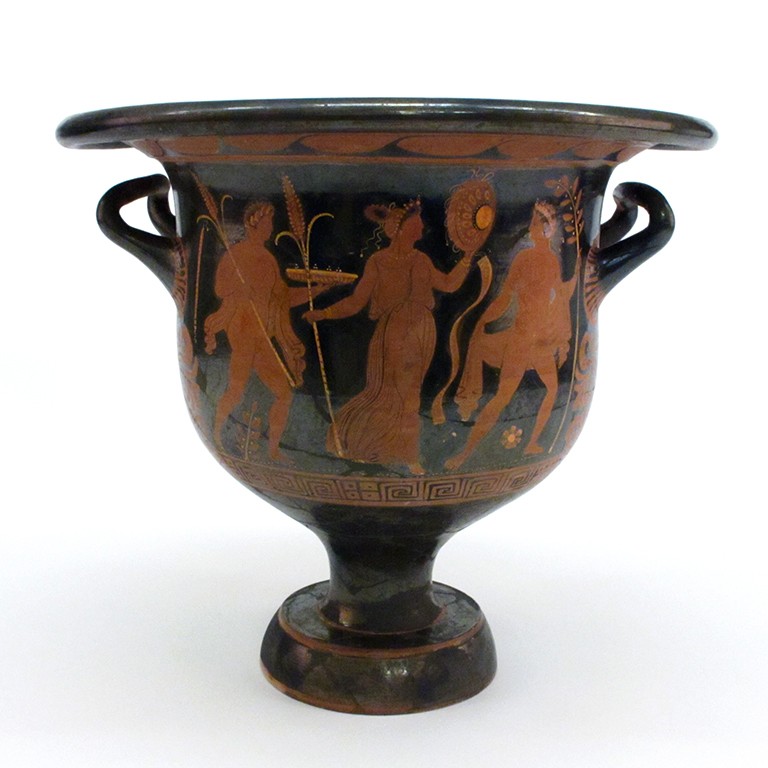 |
7. Grecian Krater: Originating from Apulia in southern Italy, this Greek bell krater would have been used to dilute wine by mixing it with water. Perhaps contrary to what one might expect, the Greek god of wine, Dionysius approved of lowering the beverage’s ABV and both he and the revelers seen on this vessel are common decorative fare. |
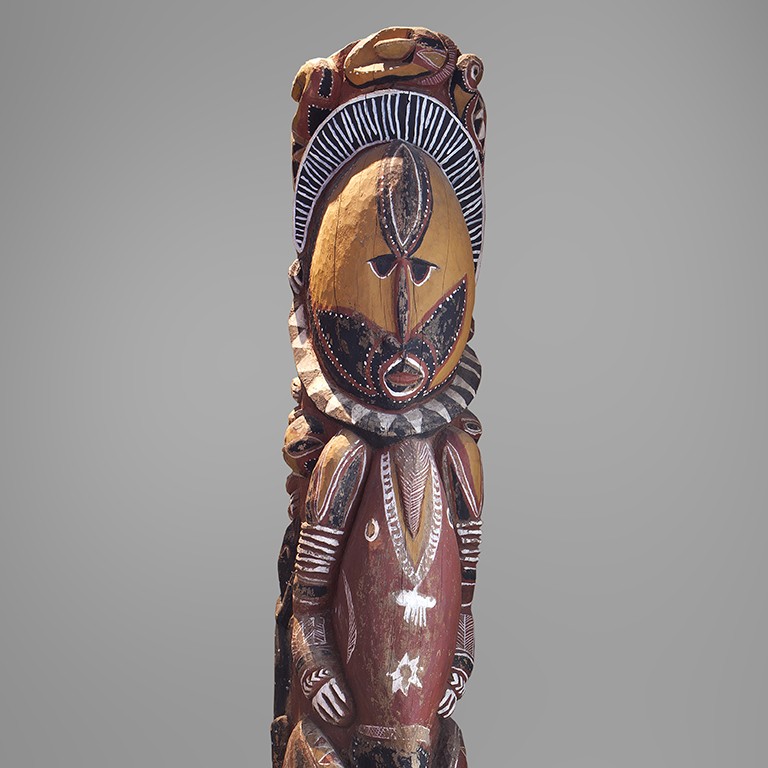 |
8. Abelam Ancestor Figure: This totemic wooden sculpture represents a ngwalundu, a supernatural spirit-being associated with clan ancestors, and would have been found inside an Abelam Haus Tambaran. These figures, some ten to fifteen feet high, are ritually painted and repainted for ceremonies and displayed to young men being initiated into adulthood. The refurbishing is thought to ensure the ancestor's continuing cooperation in the affairs of the community. This figure is still on display by the Bowers’ Main St. entrance. |
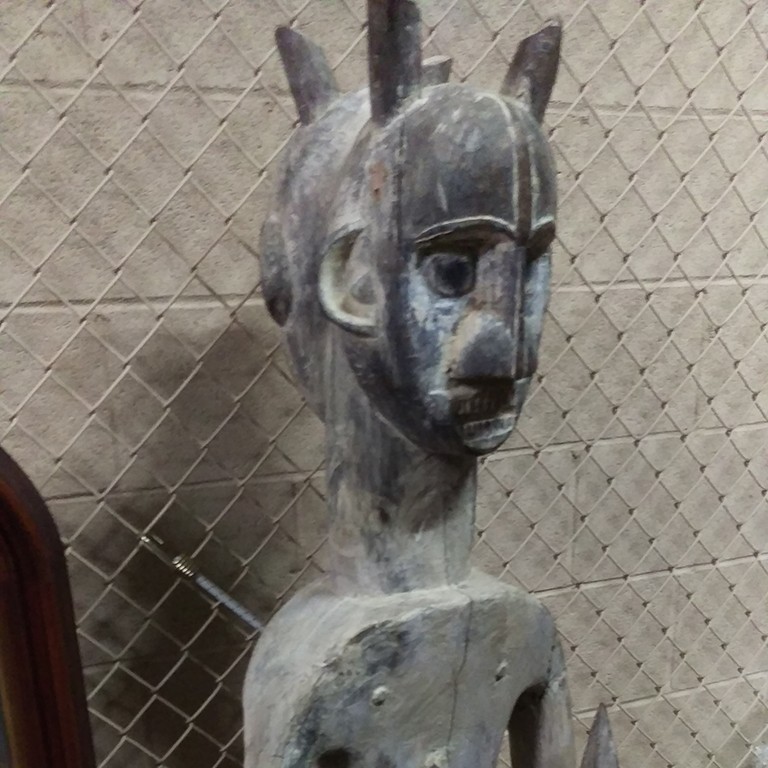 |
9. Ijaw Janus Figure: Anguiano’s cubistic depiction of this sculpture as two conjoined figures perhaps captures the symbolism of this single object better than its physical appearance. Janus is the Roman god of portals, time and duality. His two-faced portrayal is the reason why similarly bi-countenanced figures from around the world bear his name as a descriptor. This Ijaw Janus figure is a wooden likeness of a very important man. Both the sword in the left hand and the staff in the right are icons of authority. This object was transferred to the Connecting Cultures Mobile Museum in Los Angeles so that it could be used as an educational tool. |
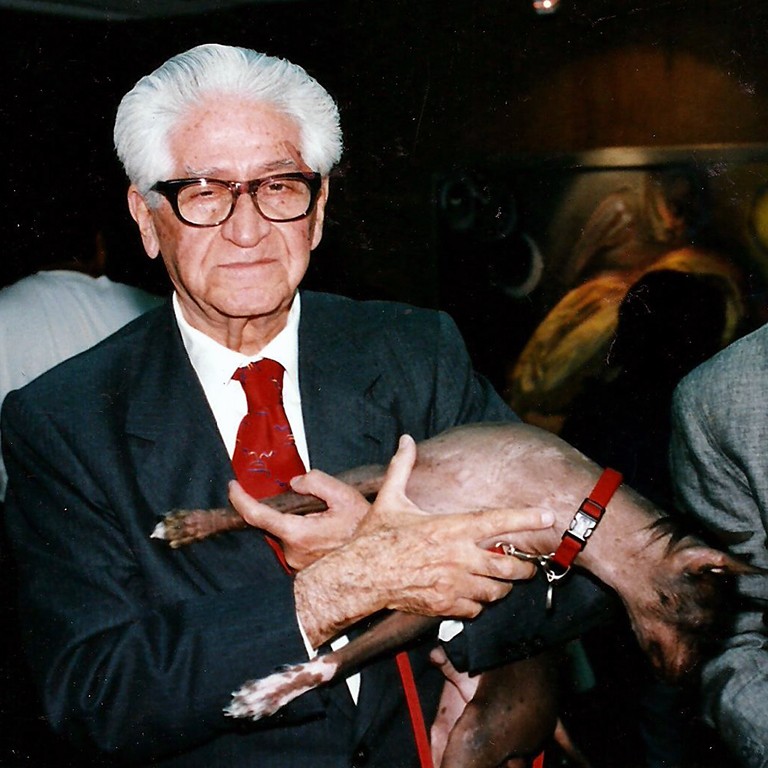 |
10. Tajin: This patient pup is Anguiano’s own loyal Xoloitzcuintli (also known as the Mexican hairless) named Tajin. Many famous Mexican painters including Diego Rivera owned Xoloitzcuintli and their history, as well as repeated appearances in 20th Century Mexican art, led them to become the national dog of Mexico. Anguiano and Tajin were inseparable, and kept each other company throughout Anguiano painting the mural. |
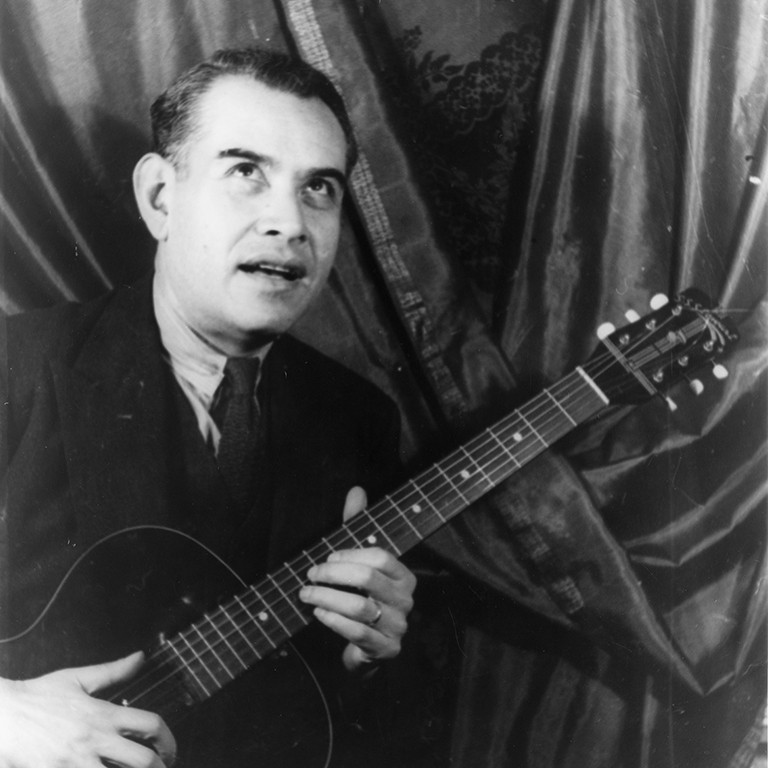 |
11. Tamayo’s Watermelon: Visitors to the recent Dimensions of Form: Tamayo & Mixografía will likely recognize this style of watermelon. Tamayo was a mentor to Anguiano and following the death of the innovative artist in 1991 Anguiano payed homage to him with this Easter egg. |
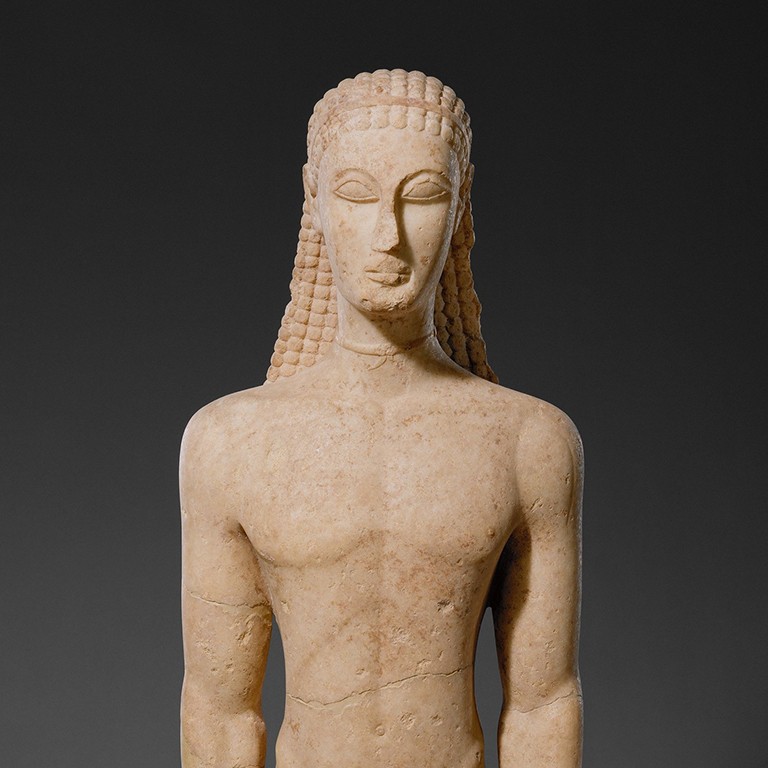 |
12. Grecian Kouros: The final three elements of the mural are not from the Bowers’ collections and do not directly pertain to Anguiano’s life. Due to the surrounding geometry of the composition, the “tondo” appears almost as a painting within a painting and apparently depicts the Metropolitan Museum of Art’s marble statue of a kouros (youth). Interestingly, in Anguiano’s original design he had planned to paint the full body of the figure. |
 |
13. Mesoamerican Pyramid: The step pyramid depicted in this painting appears to not represent one specific Mesoamerican pyramid, but to instead serve as an apotheotic pastiche made from several monumental structures including the Pyramids of the Sun and Moon in Teotihuacán. |
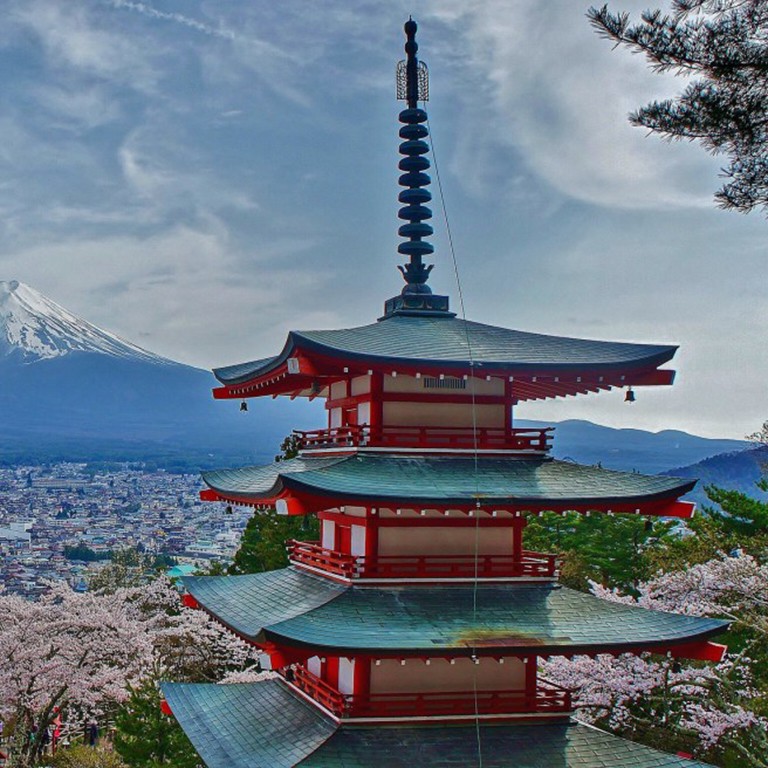 |
14. Japanese Pagoda: Though equally associated with China and Japan, the multi-tiered pagoda featured in this mural appears from its bluish spire to potentially be the Chureito Pagoda in Fujiyoshida, Japan. |
An awful lot went into Raúl Anguiano painting the mural. Be sure to take a good, long look at it when we can return to the Bowers!
| Image Credits |
| 1 |
Shalako Mana Kachina, c. 1870-1880
Hopi culutre; Northeastern Arizona
Cottonwood root, pigment and cotton thread
F79.35.1
Bowers Museum Foundation Purchase with a matching grant from Rockwell International Orange County Facilities
|
| 2 |
Metate in the Form of a Jaguar, 4th to 7th Century
Guanacaste-Nicoya Zone; Costa Rica
Volcanic stone; 12 3/8 x 11 5/8 x 30 1/4 in.
97.40.1
Dr. James Block Pick and Dr. Rosalyn M. Laudati Fund Purchase
|
| 3 |
Seated Female with Flower, 1000-1520
Huastec Culture; Northern Veracruz, Mexico
Fired Clay
85.27.2
Anonymous Gift
|
| 4 |
Stirrup Vessel, 400-600
Moche culture; North Coast, Peru
Ceramic and paint
F80.9.1
Bowers Museum Foundation Acquisition Fund Purchase
|
| 5 |
Olla, early 20th Century
Acoma culture; New Mexico
Clay and paint; 14 3/4 x 13 1/2 in.
F8776
Gift of the James Irvine Foundation |
| 6 |
Terracotta Horse, 206 BCE-220 CE
Han Dynasty; China
Terracotta
98.79.1a,b
Gift of Mr. Stephen Chandler
|
| 7 |
Bell Krater (Mixing Bowl), c. 325 BCE
Greek Apuleian culture; Southern Italy
Fired clay
81.56.1
Gift of Dr. Nicholas A. Bercel
|
| 8 |
Sculpture, 20th Century
Abelam people; Sepik River region, East Sepik Province, Papua New Guinea, Melanesia
Wood
F81.2.4
Formerly in the collection of Ruth and George C. Kennedy
|
| 9 |
Janus Figure, early 20th Century
Ijaw culture; Nigeria
Wood and kaolin
F77.30.4
Gift of Dr. & Mrs. Daniel Solomon
|
| 10 |
Photograph of Anguiano with Tajin, c. 2000
|
| 11 |
Rufino Tamayo taken by photographer Carl Van Vechten, 1945
|
| 12 |
Marble statue of a kouros (youth), c. 590–580 BCE
Metropolitan Museum of Art
|
| 13 |
Pyramid of the Moon in Teotihuacán, 2006
|
| 14 |
Chūrei-tō pagoda and Mount Fuji with cherry blossoms in the Arakurayama Sengen Park, Fujiyoshida, Yamanashi, 2016
Photograph by Manishprabhune, licensed under CC BY-SA 4.0
|
Text and images may be under copyright. Please contact Collection Department for permission to use. References are available on request. Information subject to change upon further research.


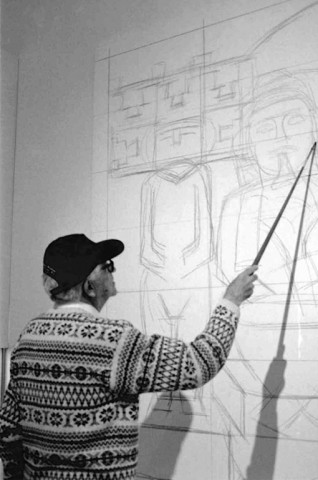
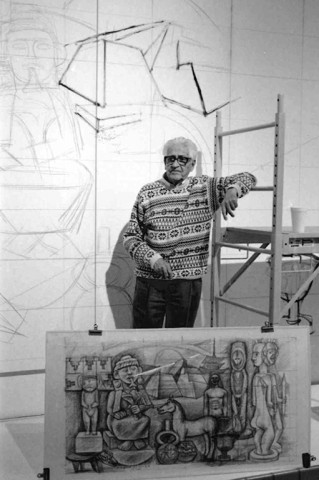















Comments